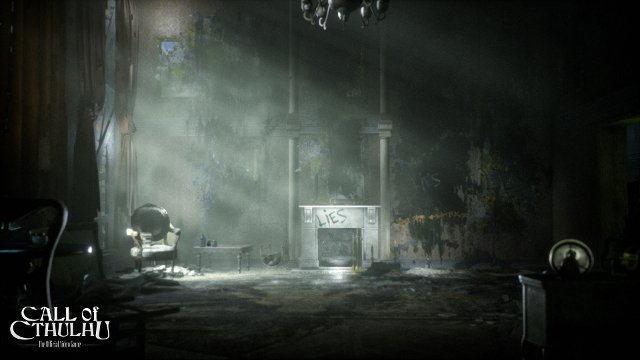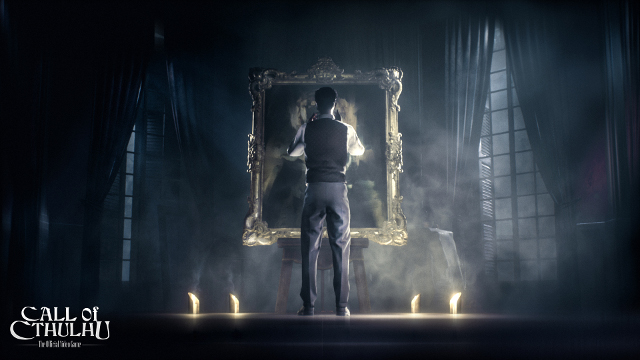I spent the entirety of Cyanide Studio’s Call of Cthulhu presentation wondering if there was something beyond the curtain. Literally.
We were cramped into a small space drenched in eldritch green, a corner of the hall decorated to look like any other creepy living room from the early twentieth century. In one corner, a black curtain closed off what could have been a doorway into another dimension (in hindsight, it was probably the developer’s break room). On the mantle was an unabashedly anachronistic flat screen television that glowed with our first glimpse into the studio’s adaptation of the pen and paper RPG classic. And while it was a very early look, what was shown promised a unique experience that could make it stand out among this generation’s horror games.
The hands-off demo began with private-eye-protagonist Edward Pierce approaching the newly-arsoned Hawkins Manor. While the local police were quick to write off the fire as an accident, Pierce (and presumably, his client) is convinced otherwise. Before reaching the manor, he happens upon the gravestones of the dearly departed Hawkins family, noting the absence of flowers for Mr. Hawkins. Without a key, Mr. Pierce attempts to enter the manor by force, only to be stopped by the still-living-somehow groundskeeper. A radial wheel of dialogue options appear, and it is here where the game first shows its RPG roots.
The success of any given option is based on a skill check and roll of the dice. Pierce can be smooth, he can be intimidating or he can be informed. Having noticed the lack of flowers on Mr. Hawkins grave, a new dialogue option becomes available. Putting two and two together, Pierce points out the groundskeeper’s care for the lady of the house and is able to appeal to the groundskeeper’s empathy and obtain entry into the manor.
Once inside, Pierce finds his way into the living room; or rather, the smoldering ruins of what used to be a living room. It is here where an integral part of Cthulhu’s gameplay comes into play. Unlike most games, where “investigation” translates to “scan every item in the room to continue” (I’m looking at you, Batboy), Call of Cthulhu puts the burden of investigation almost wholly on the player. It is not enough to simply find a clue. The time on the clock’s mantle only becomes important when digging through the police report and recognizing that the time reported does not match. Players are tasked with putting together “leads,” or corresponding pieces of information. Leads can be bad or misinformed, which can affect the progression of the story. The game’s story does not stand by and wait for the player to make the “right” choice.
In addition, the knowledge gained from observing clues is based on their skills. Pierce might look at an otherwordly painting, for example, and either recognize it or be completely clueless to what it could mean based on a player’s placement of skill points. As the story progresses, there are opportunities for Pierce to learn more about what lies beyond the veil of reality. This knowledge comes with a cost, however, as anyone who has played the original board game or has read Lovecraft surely knows. Sanity is a precious commodity, and how it can be taken from Pierce was hinted at in the second half of our demo.

In a room that can only be described as Hannibal Lecter’s art gallery, Pierce finds himself fixated on a painting toward the back. Sarah Hawkins, lady of the house, was apparently also an artist, with an entire wing of the house built to showcase her work. Anyone who has ever passed by the Lovecraft section of a Barnes and Noble can imagine the sort of unsettling images on display. A glass display case houses several weapons, including a tentacled dagger. Pierce, entranced by the painting still on its easel, reaches to touch it. And that’s when the real fun begins.
While detective work is the primary gameplay mechanic in Call of Cthulhu, it would not be a proper horror experience without some indescribably fleshy creature giving chase. Unofficially dubbed as “encounters,” parts of the game will have Pierce avoiding said fleshy creatures while searching for a means of killing it. As a private eye, Pierce is armed, but bullets will only stun them temporarily. Ducking into a nearby closet to hide, a meter on the lower left side of the screen begins to drain. It just so happens that Pierce is claustrophobic. In fact, Pierce will gain multiple phobias throughout the course of the story, each one making it that much harder to keep sanity in check. It is not long before the meter drains completely and Pierce is forced to make a run for it, the creature not far behind.
The encounter ended with Pierce driving the tentacled dagger found in the glass case into the painting, causing the creature to scream in agony and defeat. I later found that it is very possible for players to choose the wrong dagger to use. Those who take the time to study the environments and gain the correct knowledge can avoid a drawn out fight, keeping their wits and their sanity about them. Investigation and good detective work forms the crux of Call of Cthulhu, which will hopefully aid it in paying proper tribute to the game and works from which it is inspired.







